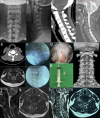Posterior Percutaneous Endoscopic Cervical Discectomy for Single-Segment Cervical Spondylotic Radiculopathy: A Retrospective Study with Minimum 3-Year Follow-Up
- PMID: 40520811
- PMCID: PMC12165176
- DOI: 10.2147/JPR.S519127
Posterior Percutaneous Endoscopic Cervical Discectomy for Single-Segment Cervical Spondylotic Radiculopathy: A Retrospective Study with Minimum 3-Year Follow-Up
Abstract
Background: Posterior percutaneous endoscopic cervical discectomy (P-PECD) has been increasingly used for cervical spondylotic radiculopathy (CSR), while few studies have reported on its medium-long-term outcomes. This study aims to investigate the medium-long-term efficacy and imaging findings of P-PECD in the treatment of single-segment CSR.
Methods: The data of 51 patients with single-segment CSR treated with P-PECD were retrospectively analyzed. Efficacy was evaluated using visual analog scale (VAS) scores of neck and arm, Japanese Orthopaedic Association (JOA) score, neck disability index (NDI), and modified Macnab criteria. Radiologic parameters were measured before and after the operation, including cervical Cobb angle, range of motion (ROM), intervertebral space height, as well as horizontal and angular displacement at the operative level.
Results: The VAS scores of neck and arm, JOA score, and NDI were significantly improved postoperatively compared with those before the operation, and the differences were statistically significant (P <0.05). Based on the modified Macnab criteria at the final follow-up, 94.12% showed excellent to good outcomes. Postoperatively, the cervical Cobb angle was 10.63 ± 1.79°, ROM was 6.33 ± 1.11°, the intervertebral space height was 4.63 ± 0.85 mm, horizontal and angular displacement at the operative level were 0.88 ± 0.68 mm and 4.25 ± 1.04°, respectively, and there were no significantly changed at the final follow-up.
Conclusion: P-PECD for single-segment CSR has the advantages of less trauma, less bleeding, a low complication rate, faster postoperative recovery, and less impact on cervical mobility and stability, which has excellent medium-long-term efficacy.
Keywords: cervical spondylotic radiculopathy; discectomy; minimally invasive; percutaneous endoscopic.
© 2025 Wang et al.
Conflict of interest statement
The authors declare that they have no competing interests.
Figures

Similar articles
-
Minimally Invasive Full-Endoscopic Posterior Cervical Foraminotomy Assisted by O-Arm-Based Navigation.Pain Physician. 2018 May;21(3):E215-E223. Pain Physician. 2018. PMID: 29871377
-
A comparison study of posterior cervical percutaneous endoscopic ventral bony decompression and simple dorsal decompression treatment in cervical spondylotic radiculopathy caused by cervical foraminal and/or lateral spinal stenosis: a clinical retrospective study.BMC Musculoskelet Disord. 2020 May 11;21(1):290. doi: 10.1186/s12891-020-03313-2. BMC Musculoskelet Disord. 2020. PMID: 32393314 Free PMC article.
-
Clinical efficacy and learning curve of percutaneous endoscopic cervical discectomy for symptomatic cervical spondylotic radiculopathy.J Orthop Surg Res. 2025 Feb 5;20(1):138. doi: 10.1186/s13018-025-05530-8. J Orthop Surg Res. 2025. PMID: 39910398 Free PMC article.
-
Comparison of clinical efficacy of posterior percutaneous endoscopic cervical discectomy versus unilateral biportal endoscopy key-hole techniques for cervical spondylotic radiculopathy: a retrospective study with 2 years.J Orthop Surg Res. 2025 Feb 25;20(1):200. doi: 10.1186/s13018-025-05617-2. J Orthop Surg Res. 2025. PMID: 40001180 Free PMC article.
-
Morphology of Herniated Disc as a Predictor for Outcomes of Posterior Percutaneous Full-endoscopic Cervical Discectomy in Treating Cervical Spondylotic Radiculopathy.Orthop Surg. 2021 Dec;13(8):2335-2343. doi: 10.1111/os.13134. Epub 2021 Nov 9. Orthop Surg. 2021. PMID: 34755465 Free PMC article.
References
-
- Ren J, Li R, Zhu K, et al. Biomechanical comparison of percutaneous posterior endoscopic cervical discectomy and anterior cervical decompression and fusion on the treatment of cervical spondylotic radiculopathy. J Orthopaedic Surg Res. 2019;14(1):71. doi: 10.1186/s13018-019-1113-1 - DOI - PMC - PubMed
LinkOut - more resources
Full Text Sources

